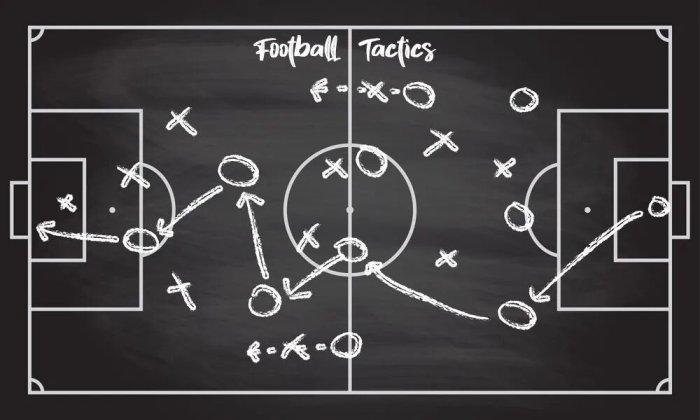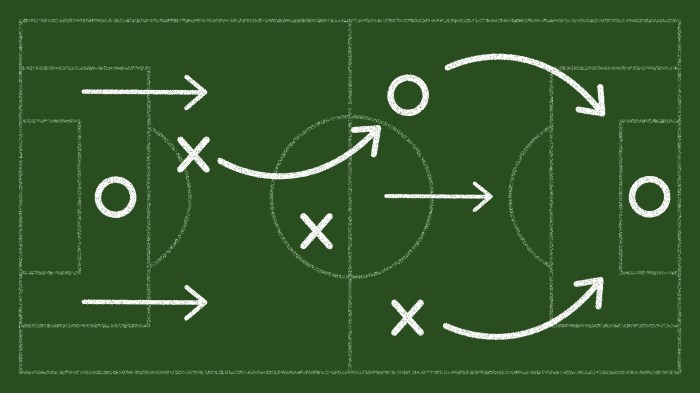Football tactics are the game-changers that determine victory or defeat on the field. Get ready to dive into the world of offensive and defensive strategies, set-piece plays, and more in this ultimate guide to dominating the game.
Whether you’re a die-hard fan or a rookie looking to up your game, understanding these tactics will take your football knowledge to the next level.
Overview of Football Tactics
Football tactics are strategic plans employed by teams to achieve specific goals during a match. These tactics are crucial in the game as they help teams control possession, create scoring opportunities, and defend effectively against their opponents. By implementing different tactics, teams can adapt to various situations on the field and outsmart their rivals.
Famous Football Tactics
- One of the most famous football tactics is the “Tiki-Taka” style popularized by Barcelona under coach Pep Guardiola. This tactic focuses on quick, short passing and maintaining possession to control the pace of the game.
- Another renowned tactic is the “Counter-Attack,” utilized by teams like Real Madrid and Liverpool. This strategy involves quickly transitioning from defense to offense to catch opponents off guard and capitalize on their mistakes.
- The “Gegenpressing” tactic, introduced by Jurgen Klopp at Borussia Dortmund and later Liverpool, emphasizes intense pressing and immediate regaining of possession to disrupt the opponent’s build-up play.
Offensive Tactics

In the game of football, offensive tactics play a crucial role in creating scoring opportunities and breaking down the opponent’s defense. Teams often employ various strategies to outwit their rivals and secure victories on the field.
Teams utilize different offensive strategies to gain an advantage over their opponents. One popular tactic is tiki-taka, a style of play characterized by quick, short passes and movement off the ball. This strategy focuses on maintaining possession and wearing down the opposition through constant circulation of the ball.
Another effective offensive strategy is the counter-attack, where teams look to exploit open spaces behind the opponent’s defensive line. By quickly transitioning from defense to offense, teams can catch their rivals off guard and create scoring opportunities in a matter of seconds.
Wing play is also a common offensive tactic used by teams to stretch the opponent’s defense and create crossing opportunities from the flanks. By utilizing fast and skillful wingers, teams can deliver dangerous balls into the box and capitalize on scoring chances.
Teams adapt their offensive tactics based on the opponent’s strengths and weaknesses to exploit any vulnerabilities. For example, if the opponent has a slow defensive line, teams may opt for a high-pressing strategy to force turnovers and capitalize on the lack of pace in the backline.
Successful offensive tactics often lead to goals and victories on the field. For instance, a well-executed tiki-taka style of play can result in intricate passing sequences that unlock the opponent’s defense and lead to scoring opportunities. Similarly, a clinical counter-attack can catch the opposition off guard and result in a decisive goal that changes the course of the game.
Tiki-Taka Strategy
The tiki-taka strategy emphasizes quick, short passes and movement off the ball to maintain possession and create scoring opportunities. Teams that excel in tiki-taka often exhibit exceptional technical skills and teamwork to break down the opponent’s defense.
- Constant movement off the ball to create passing lanes
- Quick, short passes to maintain possession and control the tempo of the game
- Patient build-up play to wear down the opponent’s defense
- Utilization of triangles on the field to provide passing options
Defensive Tactics
When it comes to defensive tactics in football, it’s all about preventing the opposition from scoring while also creating opportunities to regain possession of the ball.
From formations to strategies, a solid defense can make or break a team’s performance on the field. Let’s dive into some key aspects of defensive tactics in football.
Various Defensive Formations, Football tactics
Different defensive formations are used by teams to solidify their defense and thwart the opposition’s attacks. Some common formations include:
- The flat back four: This formation consists of four defenders in a flat line across the back, providing stability and cover in front of the goal.
- The sweeper system: In this formation, a sweeper plays behind the defensive line, acting as the last line of defense and providing cover for the backline.
- Zonal marking: This strategy involves defenders marking specific zones on the field rather than individual players, allowing for better coverage and coordination.
Role of Pressing, Marking, and Defensive Transitions
Pressing, marking, and defensive transitions are essential aspects of defensive tactics in football:
- Pressing: Teams use pressing to apply pressure on the opposition players in order to win back possession quickly and disrupt their attacking play.
- Marking: Effective marking involves defenders closely tracking and covering opposition players to limit their movement and chances to score.
- Defensive transitions: Teams must be able to transition quickly from attacking to defensive positions when they lose possession, ensuring they are organized and compact at the back.
Adjusting Defensive Tactics During Different Phases of the Game
Teams often adjust their defensive tactics based on the phase of the game and the current scoreline. Here are some common adjustments:
- When leading: Teams may adopt a more conservative approach, focusing on maintaining their lead and protecting their goal.
- When trailing: Teams might push more players forward and take risks to try and equalize or turn the game in their favor.
- During set-pieces: Defenses need to be organized and alert during set-piece situations to prevent the opposition from scoring from corners or free-kicks.
Set-Piece Tactics

Set-piece tactics play a crucial role in football, as they provide teams with opportunities to score goals or create scoring chances from corners, free-kicks, and throw-ins. Teams often strategize and practice specific routines to maximize their effectiveness during set-piece situations.
Corner Kicks
Corner kicks are one of the most common set-piece situations in football. Teams usually have set routines for both attacking and defending corners. During attacking corners, players position themselves strategically in the box to create scoring opportunities, while defenders mark their opponents tightly to prevent goals.
Free-Kicks
Free-kicks offer teams a chance to score directly from a set-piece situation. Teams may opt for a direct shot on goal or employ more elaborate routines involving decoy runners, dummy passes, or rehearsed set plays to confuse the opposition’s defense. Effective free-kick routines require precision, timing, and coordination among the players.
Throw-Ins
While throw-ins may not always result in immediate scoring opportunities, they are still considered set-piece situations that teams can capitalize on. Players may use throw-ins to quickly restart play, create attacking opportunities, or retain possession by utilizing specific routines or movements off the ball.
Examples of memorable goals scored from set-pieces include Cristiano Ronaldo’s header from a corner kick in the 2018 World Cup against Spain, or Lionel Messi’s free-kick goals showcasing his precision and technique. These examples highlight the importance of set-piece tactics in football and how they can impact the outcome of a match.